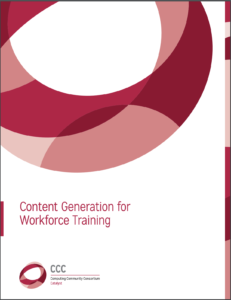
The Computing Community Consortium (CCC) is pleased to announce the release of a new CCC workshop report called Content Generation for Workforce Training. This report is based on presentations and discussions at the CCC workshop Content Generation for Workforce Training that was held March 14-15, 2019 in Atlanta, Georgia, and a follow-up workshop by the same name held July 28, 2019 at the ACM SIGGRAPH conference in Los Angeles. The workshops brought together researchers in a variety of computer disciplines related to content creation and practitioners in workforce training.
Efficient workforce training is needed in today’s world in which technology is continually changing the nature of work. Students need to be prepared to enter the workforce. Employees need to become lifelong learners to stay up-to-date in their work and to adapt when job functions are eliminated. The training needs are across all industries – including manufacturing, construction, and healthcare. Computing systems, in particular Virtual/Augmented Reality systems, have been adopted in many training applications and show even more promise in the future. However, there are fundamental limitations in today’s systems that limit the domains where computing systems can be applied and the extent to which they can be deployed. These limitations need to be addressed by new computing research. In particular, research is needed at multiple levels:
- Application Data Collection Level Requiring High Security and Privacy Protections:
- New techniques for capturing job knowledge that integrate sensing systems, natural language processing of existing documents and anthropological methods.
- New techniques for effective evaluation of trainees that integrate sensing systems.
- Training Material Authoring Level:
- Understanding level of realism needed for different types of training.
- New representations between 2D images and full 3D scenes.
- New methods to maintain relationship between CAD objects and training systems.
- New methods to organize and share digital assets.
- Machine learning techniques to create training scenarios within specific constraints.
- New systems that allow smooth transitions between fully virtual and fully physical.
- New techniques for authoring systems with a human trainer in the loop.
- Software Systems Level:
- Development of new VR/AR authoring systems that focus on training issues such as integrating different types of training materials rather than on computer game design.
- Development of new VR/AR software engines to replace game engines that don’t allow for detailed simulations needed by specific training scenarios and interpersonal interaction required in training.
- Development of new VR/AR interaction and visualization techniques directly relevant to training, such as where and how tasks are to be performed.
- Hardware Level:
- Efficient mobile computing systems to support AR/VR deployment at low cost.
- Hardware for interaction that is ADA compliant.
- Efficient/secure networking for training of groups.
To accomplish these research goals, a training community needs to be established to do research in end-to-end training systems and to create a community of learning and domain experts available for consulting for in depth computing research on individual system components.









